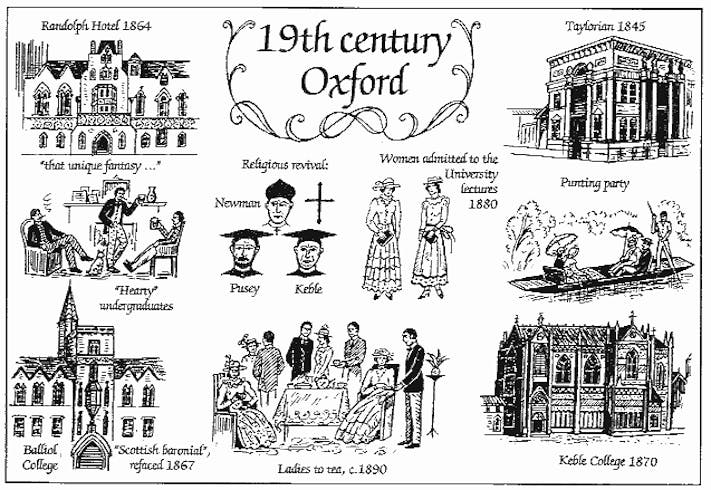19th Century Oxford

For Oxford, the nineteenth century was a time of supreme confidence, vigorous debate, and a sense of orderly progress. It was certainly a masculine stronghold, which fostered great men, and loyal citizens:
"For ever ancient, and for ever new,
Oxford, thy courts and cloisters are a bower
Whence thought - earth-shaking and earth-shaping - drew
Promise and Power;
Here coming rulers, who will one day wield
Old Empire's rod, our England's finest flower,
Practise their prentice-hands in mimic strife,
And playing the field,
Learning the Master's touch and maker's life;
While Isis ripples with its storied stream,
And every rill a hope and haloed dream."
- Frederick William Ward, from 'Oxford the Dreamer'
One of the great men was Gladstone, who having obtained a double first in Classics and Mathematics in 1831, was a lifelong devotee: "To call a man an Oxford man is to pay him the highest compliment that can be paid to a human being." Controversial figure Cecil Rhodes felt similarly: although he only stayed for one term he felt strong emotional attachment and established the Rhodes Scholarship specifically to send students from around the world to Oxford.
The emphasis was not entirely chauvinistic, however. Other notable figures included Hilaire Belloc, Charles Dodgson (aka Lewis Carroll), Francis Kilvert the diarist, and Oscar Wilde, as well as the great leaders of the 'Oxford Movement' through which the Anglo-Catholic branch of the Church of England was established.
During the nineteenth century, river sports, always popular, inspired almost fanatical enthusiasm. "It is characteristic of the authorities at Oxford", wrote George Bernard Shaw in 1898, "that they should consider a month too little for the preparation of a boat-race, and grudge three weeks to the rehearsals of one of Shakespeare's plays." The Oxford-Cambridge Boat Race was first rowed at Henley in 1829 (Oxford won). The river was also the scene of more leisurely pursuits, and it was during boating trips with Alice Liddell and her friends that Charles Dodgson first began to weave the tales that became 'Alice in Wonderland.'
The Taylorian houses the Modern Languages facility, and at first sight appears to be part of the Ashmolean Museum. The Ashmolean block was originally known as 'Sir Robert Taylor's Institution and the University Galleries'.
Keble College is built of a striking mixture of red, black and cream coloured bricks. It has been called the Zebra College, or the Knitted College (owing to its resemblance to a Fair Isle sweater), and has also been likened to streaky bacon, a railway station etc etc.



